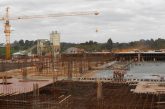
The Bus Rapid Transit (BRT) system has begun taking shape with remodelling of Thika Superhighway. Nairobi Metropolitan Area Transport Authority (NaMATA) confirmed the report and said that works on pick-up and drop-off points are currently in progress to pave way for high-capacity express buses that will use the inner lanes on both sides of the dual carriage.
The BRT concept which envisions to transform mass transportation of people, aims to decongest the city and reduce travel time. The system covers Nairobi City County and the adjoining counties of Kiambu, Kajiado, Machakos, and Murang’a. The interconnected BRT lines are named after Kenya’s Big Five animals: Simba (Lion), Kifaru (Rhino), Chui (Leopard), Ndovu (Elephant), and Nyati (Buffalo).
On the Thika Highway, the points linked to footbridges will serve as BRT stations erected along islands between the carriageways. This means passengers boarding or alighting will not have to worry about crossing through the lanes. The stations have been designed in such a way that access and exit from the stations is through the footbridge. This results to no room for commuters to slip or sneak through motorways. This is part of an integrated public transport service linked to Nairobi Commuter Rail Network (NCRN) that has commuter stations in in Kikuyu, Embakasi Village, Pipeline, Donholm, Dandora, Kahawa, Ruiru, Athi River, Githurai and Mwiki.
Cost-effective services at metro-level capacities
So far, works on designated BRT stations are ongoing at Safari Park, Roysambu, Clayworks, Kahawa Barracks and Kenyatta University. According to Namata Chief Executive Officer Francis Gitau, the bus rapid transit will deliver fast, comfortable and cost-effective services at metro-level capacities.
“The exclusive lanes and scheduled travel is expected to drastically reduce travel time to and from the Central Business District. It will do this through the provision of dedicated lanes, with busways and iconic stations typically aligned to the centre of the road, off-board fare collection, and fast and frequent operations. According to World Bank estimates, city residents on average spend an hour to travel to work and another 60 minutes commuting back home due to traffic congestion,” said Namata.





